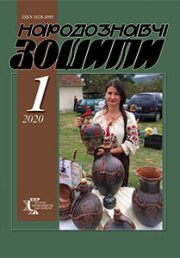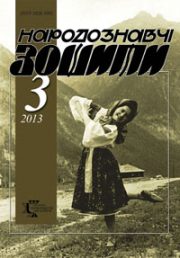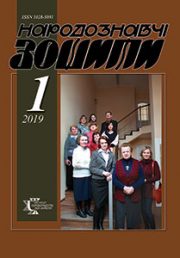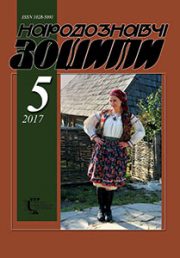The Ethnology Notebooks. 2023. № 2 (170), 448—458
UDK94(477.87+438+437.6=161.2)”19″
DOI https://doi.org/10.15407/nz2023.02.448
LEMKIVSTVO UNDER THE INFLUENCE OF «VELVET CHANGES» IN CENTRAL-EASTERN EUROPE
LYUBCHYK Ihor
- ORCID ID: https://orcid.org/0000-0003-4649-5785
- Doctor of Historical Sciences, Associate Professor, Professor,
- Ivano-Frankivsk National Medical University,
- Department of Ukrainian Studies and Philosophy,
- 2 Halytska St., 76000, Ivano-Frankivsk, Ukraine,
- Contacts: e-mail: lubczyk-79@ukr.net
Abstract. Lemkivstvo is a general category of the community of natives of Lemkivshchyna, representatives of the Lemkos ethnographic group, their heirs, popularizers and connoisseurs of this most picturesque western ethnic group. The territory of Lemkivshchyna generally is part of the Polish-Ukrainian-Slovak borderlands. Lemkivstvo is a rich field for ethnopolitical research, especially such a scientific problem as the influence of official political practices on the identification manifestations of the people of the borderlands and their local and national identities. The article aims to analyse the Lemkos community’s situation under the influence of the «velvet changes» in Eastern Europe as a significant factor in social transformations in the borderlands. The source base of the work consists of rich material collected over a long period. The territory of the study covers the geographic area of the residence of the Lemkos and their descendants in Ukraine, Poland and Slovakia. Source material completely exhausts the object and subject of research. The research methodology is grounded on theoretical analysis, systematization and generalization, the historical review and observations of the author. After systematic analysis, careful research visions, balanced evaluations and generalization, the author concludes that the Lemkivstvo, under the influence of the «velvet changes» in Eastern Europe, have once again found themselves at the epicentre of the political struggle, whose leaders, often ignoring the principles of historical traditions and ethnocultural integration, manipulate national priorities, thus strengthening regional markers of Lemko/Ruthenian identity. The competitive nature of both approaches, strengthened by a structured public initiative well rooted in political and power circles, to overcome based on compromise solutions, seems to be an extremely difficult task today.
Keywords: Lemkivshchyna, Lemkos, Lemkivstvo, Rutheni ans, ethnopolitics, Velvet revolution, Ukraine, Poland, Slovakia.
Received 6.03.2023
REFERENCES
- Panchuk, M. (2010). Political Rusynism — anti-rusyn (Anti-ukrainian) Projekt. Karpaty: liudyna, etnos, tsyvilizatsiia. Naukovyi zhurnal z problem karpatoznavstva (Issue 2, pp. 82—96) [in Ukrainian].
- Zan, M. (2014). Peculiarities of the socio-political representation of national and ethnic minorities in Poland. Uzhhorodski polski naukovi chytannia: istoriia, kultura, polityka, pravo. Naukovyi zbirnyk. Uzhhorod: Lira [in Ukrainian].
- Kichera, N. (2014). Lemkovi in Polish ethnopolitics. Hrani, 1 [in Ukrainian].
- Halchak, B. (2012). The place of the Lemkos in the universe. Lemky, boiky, rusyny — history, present, culture (Vol. IV, part 1. pp. 113—127). Slupsk; Zelena Hura (in Polish].
- Mushynka, M. (2009). Political Ruthenism at the modern stage. Narodna tvorchist ta etnohrafiia, 4—5 [in Ukrainian].
- Sopolyha, M. (2017). Ukrainians of Slovakia: historical and ethnographic aspect Narodna tvorchist ta etnolohiia, 3 [in Ukrainian].
- Gajdos, M., & Konecny, S. (2005). Ruthenians and Ukrainians in Slovakia in the process of transformation (1989—1995). Presov: Universum [in Slovakia].
- Ivantsiv, M. (1992). Visti z Ternopilskoho tovarystva «Lemkivshchyna». Lemkivshchyna, 3 [in Ukrainian].
- Krynytskyi, S. (1992). Appeal to the Chairman FDL. Lemkivshchyna, 3 [in Ukrainian].
- (2012). Lemki in Luhansk region: pages of history and culture. Luhansk [in Ukrainian].
- (2011). The first Lemko bonfire was lit in the Poltava region. Lemkivshchyna (Part 3) [in Ukrainian].
- Yakymenko, M. (Ed.). (2007). A life torn apart by the border of a foreign land: the deportation of Lemkos from Poland to Ukraine, 1944—1947. Poltava: Simon [in Ukrainian].
- Barwinski, M. (2012). Ukrainian and Lemkovsky organizational structures in Polska in Latach 1956—2012. Universitatis Lodziensis. Folia Geographica socio-economica, 12 (in Polish].
- (2011). «Rusyns are an organic component of the Ukrainian nation…». Lemkivshchyna, 3 [in Ukrainian].
- Hladyk, S. (1991). In Lemkivshchyna about Lemkivshchyna Lemkivshchyna (Part 3) [in Ukrainian].
- Hula, V. (1991). Association of Lemki — organization «Lemkivshchyna». Lemkivshchyna (Part 3) [in Ukrainian].
- V., H. (1992). Pysmo, adresovane holovi FDL. Lemkivshchyna, 3 [in Ukrainian].
- Bidzilia, Yu. (2013). Problems of functioning of the Ukrainian studies press in Slovakia. Naukovi zapysky Tavriiskoho natsionalnoho universytetu im. V.I. Vernadskoho. Seriia «Filolohiia. Sotsialni komunikatsii», 3 (Vol. 26) [in Ukrainian].
- Mushynka, M. (1991). New organizations of Lemkos of Pryashiv region. Lemkivshchyna, 3 [in Ukrainian].
- Mulesa, V. (2009, May-June). To all his possessions. Lemkivshchyny bells, 3 [in Ukrainian].
- Vovkanych, I., & Siusko, I. Optatsiia mizh ChSR i SRSR v 1945—1947 rr. ta problemy movy i osvity. Retrieved from: http: www.clovekaspolocnast.sk/jguery/pdf.php?gui (Last accessed: 27.02. 2021 r.).
- Almashii, V. (2010). The First World Congress of Ruthenians in Medzhilabyrtsi 23—24 bereznia 1991 roku and its prerequisites. Naukovyi visnyk Uzhhorodskoho univerytetu. Seriia politolohiia, sotsiolohiia, filosofiia (Issue15) [in Ukrainian].
- Myshanych, O. (1999). Political Rusynism and what is behind it? Lemkivshchyna, 4 [in Ukrainian].
- (1994). New Lemkovsky (and not Lem) journals. Besida, 2 (in Polish].
- Ustawa Rzeczypospolitej Polskiej o Mniejszosciach Narodowych i Etnicznych oraz o Jezyku Regionalnym vid 6 sichnia 2005 r. Retrieved from: http://language-policy.info/movne-zakonodavstvo/polska-respublika/zakon-polskoji-respubliky-pro-natsionalni-ta-etnichni-menshyny-ta-pro-rehionalnu-movu/ (Last accessed: 27.02.2021 r.).
- (2011). Lemkivska khronika. Vatra, 4 [in Polish].
- Masliana, A. (2015). Feast of Ruthenian culture in Poland. Ru synskyi svit, 3.
- (1992). We will not be Ukrainianized or Slowakied. Besida, 1 (in Polish].
- Lytvyn, V., Boriak, H., & Danylenko, V. (2012). The national question in Ukraine — historical essays. Kyiv: Nika Tsentr [in Ukrainian].
- Myshanych, O. (2012). Ruthenians: politics, history, culture. Uzhhorod: Hrazhda [in Ukrainian].
- Panchuk, M. (1995). Political Ruthenism in Ukraine. Political opinion. № 2—3. S. 116—123 [in Ukrainian].
- Baleha, Yu. (2003). Political Ruthenism and the construction of the Ukrainian state. Uzhhorod: Hrazhda [in Ukrainian].
- Kabachii, R. (2013). The last of the… Lemkas? Forum natsii, № 7—8. Retrieved from: http://www.forumn.kiev.ua/newspaper/archive/132/ostannii-iz%E2%80%A6lemkiv.html (Last accessed: 27.02.2021 r.).
- Kostiak, N. (2011). Two versions of the narrative of the Lemki region in the works of Lemki authors in Poland. Slavia Orientalis, 1 [in Ukrainian].
- Mushynka, M. In Slovakia, the conference discussed issues of research on Ruthenians and Ukrainians in Central-Eastern Europe. Retrieved from: https://zakarpattya.net.ua/Special/131770-U-Slovachchyni-na-konferentsii-obhovoriuvaly-pytannia-doslidzhennia-rusyniv-ta-ukraintsiv-TSentralno-Skhidnoi-IEvropy-FOTO (Last accessed: 17.12.2018 r.).
- Sopolyha, M. The scientific conference «Ukrainians in the history and culture of the Carpathians» in Svydnik condemned artificial technologies of division. Retrieved from: htt ps://zakarpattya.net.ua/Special/155968-Naukova-konferentsiia-Ukraintsi-v-istorii-ta-kulturi-Karpat-u-Svydnyku-zasudyla-shtuchni-tekhnolohii-z-podilu-ukrainstva (Last accessed: 7.12.2018).
- Liubchyk, I. (2017). Lemkivschyna and Lemkos in Russian Discourse of the Modern Era: the Socio — Political and Scientific Aspect of the Problem. Ukrainian Historical Journal, 2 [in Ukrainian].







